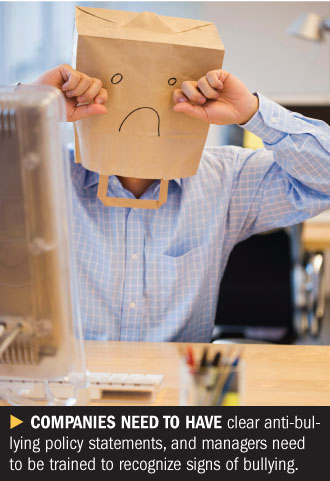"Status-blind harassment"—more commonly known as workplacebullying—is a growing concern to employers and their employmentpractices liability insurers. But while the costs of having bulliesin the workplace are clear, appropriate steps to recognize and reinin the problem aren't always obvious.
| Experts use the term"status-blind" or "equal-opportunity harassment" to distinguishworkplace bullying from harassment targeted at classes of workersprotected under federal and state statutes.
Experts use the term"status-blind" or "equal-opportunity harassment" to distinguishworkplace bullying from harassment targeted at classes of workersprotected under federal and state statutes.
"It's the boss who abuses his or her power not because someoneis a woman over the age of 40 or Hispanic, but rather because theboss wants to bully and is a bully—and anyone who gets in the wayis going to be a victim of that bullying, says Gerald Maatman Jr.,a partner of Seyfarth Shaw in Chicago.
|While there are currently no statutes outlawing bullying,lawyers and EPLI experts note that at least 10 states areconsidering legislative proposals to do just that. Even in theabsence of anti-bullying statutes, however, the experts say thereare other consequences to consider, such as employee turnover andsick days.
|Highlighting serious ramifications, Adeola Adele, EPLI productleader for Marsh's FINPRO group in New York, says, "Workplaceviolence starts with bullying." She cites a case where anindividual shot his co-workers. "The back-story was that he wasbullied at work, and no one listened."
|Aon Hewitt's Adler says training managers "to be good atmitigating the risk of bullying does not just involve focusing onthe bully's behavior, but really [means] carefully gauging theemotional state of all their employees to get a sense of whetherthey are victims."
|More generally, he explains that risk mitigation in this areareally involves two components: pre-hire assessment and performancemanagement.
|"There are things that can be done to assess perspectiveemployees for the tendency to express anger, to be aggressive, toshow excitability—all factors that can lead to bullying."
|What if bullying tendencies are revealed during the hiringprocess?
|"It would be perfectly legitimate in my view not to hiresomebody who poses a reasonable risk," Adler says, noting that hespeaks from the perspective of an organizational psychologist, nota lawyer. "Bullying can result in lawsuits, loss of talent,creating a hostile environment for employees that would cause themto leave," he says.
|What do you do if somebody is a reasonable risk and they'realready on board, or because of their talents you want to hirethem?
|• First, companies need to have clear policystatements, conveying clear expectations that bullying is nottolerated and there will be consequences.
|• Second, managers need to be trained to recognizesigns of bullying and to be responsive in taking action so they'renot contributing inadvertently to creating a hostile workenvironment.
|Recognizing behaviors related to bullying has two sides toit—recognizing the behavior of the bully, and paying attention tothe emotional states and behaviors of potential or actual victims,Adler says. He cites findings of a Canadian research studypublished last year in a leading psychology journal showing thatbullying is more likely to impact a victim's work performance thansexual harassment.
|David Carlson, Midwest Zone Leader of Marsh Risk Consulting'sWorkforce Strategies Practice, agrees there needs to be educationaround workplace bullying. Right now, he says, only "theprogressive companies are going to go out and have bullyingpolicies and training."
|"For the less progressive ones, where it may be more pervasive,it's a command-and-control issue. They're going to wait untilthey're told by state and local authorities and regulators thatthey have to do this," he says.
|Carlson says that suspected occurrences of bullying need to befully and carefully investigated, and like Adler, believes thatonce it is identified, "progressive disciplinary is typical formost organizations." But depending on the severity of the activity,"it could be grounds for immediate termination," he adds.
|"That has to come down to the policies and culture of theworkplace. Companies need to have a zero-tolerance policy foranything like workplace violence, workplace bullying or sexualharassment," he says. "There needs to be swift and immediateaction."
Want to continue reading?
Become a Free PropertyCasualty360 Digital Reader
Your access to unlimited PropertyCasualty360 content isn’t changing.
Once you are an ALM digital member, you’ll receive:
- All PropertyCasualty360.com news coverage, best practices, and in-depth analysis.
- Educational webcasts, resources from industry leaders, and informative newsletters.
- Other award-winning websites including BenefitsPRO.com and ThinkAdvisor.com.
Already have an account? Sign In
© 2024 ALM Global, LLC, All Rights Reserved. Request academic re-use from www.copyright.com. All other uses, submit a request to [email protected]. For more information visit Asset & Logo Licensing.








